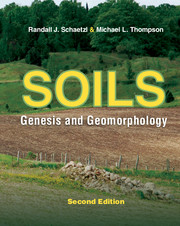12 - Models and Concepts of Soil Formation
Published online by Cambridge University Press: 12 January 2024
Summary
Soils are complex. They exist at the interface of the lithosphere, atmosphere, and biosphere and function as integral components of the hydrosphere. They inherit, react to, and affect (seemingly simultaneously) all of these realms. Erosion, burial, climate change, biomechanical movement and mixing processes, water table effects, inputs of eolian dust, microclimatic effects of aspect and topography, and innumerable other nuances of the soil-forming environment all interact to form the most complex of natural systems – soil. Soil plays a key role in global energy, water, and geochemical cycles (Bockheim and Gennadiyev 2000; Fig. 12.1). To top it off, soils have no single end point toward which they are developing. Every one of Earth's soil bodies is on its own individual journey to a destination that may be impossible to envision. How fun!
Question: How can we possibly make sense of this commotion and sensory overload? The answer: By using conceptual models that help us understand the soil system and distinguish a signal from all the noise (Minasny et al. 2008, Bockheim and Gennadiyev 2010). Conceptual models are essential tools of science; they are simplified descriptions of natural systems (Drury and Nisbet 1971). Rather than being precise mathematical descriptions that can be solved with ample data, they are used to help put soil information into perspective and provide insight into the system interrelationships, process linkages, and nuances of pedogenesis and soil geomorphology (Jenny 1941b, Cline 1961, Dijkerman 1974, Conacher and Dalrymple 1977, Burns and Tonkin 1982, Phillips 1989, 1993b, Hoosbeek and Bryant 1992, Johnson et al. 1990). Models provide a way to organize, simplify, and enumerate the factors that affect soil systems and processes (Smeck et al. 1983, Bockheim et al. 2005). They help to view things in ordered ways, organize our thoughts, and provide a conceptual framework within which to consider facts (Johnson and Watson- Stegner 1987). Some models are complex, but most try to take the complex and make it simple. They help us see the big picture. By their very nature, models are simplifications of reality. In fact, sometimes the simpler the model, the better.
Unfortunately, models can also serve as mental blinders, preventing us from seeing aspects of reality that do not necessarily fit with the model. They can constrain our viewpoint on the world and force us to see it through a certain type of conceptual lens.
- Type
- Chapter
- Information
- SoilsGenesis and Geomorphology, pp. 283 - 320Publisher: Cambridge University PressPrint publication year: 2015



